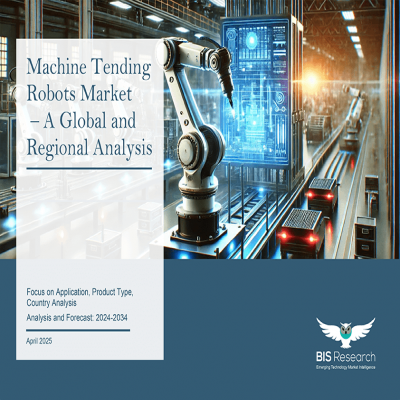Introduction to Asia-Pacific Machine Tending Robots Market
The Asia-Pacific machine tending robots market, valued at $6,715.58 million in 2024, is expected to reach $18,233.55 million by 2034, exhibiting a robust CAGR of 10.50% during the forecast period 2024-2034. The market for machine tending robots in the APAC region is mostly driven by the growing need for automation to increase industrial productivity and reduce operating costs. Manufacturers are adopting sophisticated robotic solutions as a result of growing labour shortages and the need for more precision in repetitive activities. More money is being invested in intelligent, adaptable systems, particularly as firms look to increase output consistency and streamline manufacturing. More intelligent and flexible machine tending applications are being made possible by ongoing developments in sensor technology, AI-driven controls, and machine vision. This is contributing to the strong market expansion across a variety of industries in nations including China, Japan, South Korea, and India.
Market Introduction
The market for machine tending robots in Asia-Pacific (APAC) is expanding significantly due to the region's ongoing transition to smart manufacturing, fast industrialisation, and labour shortages. Because they may increase productivity, lower operating costs, and improve workplace safety, machine tending robots—which automate the loading and unloading of parts in CNC machines, injection moulding units, and other manufacturing equipment—are becoming more and more popular in Asia-Pacific.
Government programs like "Made in China 2025" and India's Production Linked Incentive (PLI) schemes, which encourage automation, domestic manufacturing, and innovation, are helping China, Japan, South Korea, and India lead the adoption. Small and medium businesses (SMEs), who were initially apprehensive because of the high capital needs, are now progressively embracing modular solutions and collaborative robots (cobots) since they provide flexibility and a quicker return on investment.
Robot intelligence and adaptability have been improved by technological developments in artificial intelligence (AI), machine vision, and force control. This has enabled deployment in a variety of industries, including consumer products, electronics, metalworking, and automotive. The market for APAC machine tending robots is expected to grow steadily despite obstacles such high initial investment, integration complexity, and skills gaps. This growth will be aided by industrial modernisation, advantageous legislation, and the growing demand for reliable, highly accurate production methods.
Market Segmentation:
Segmentation 1: by Application
• CNC Machine Tending
• Injection Molding
• Grinding and Polishing
• Welding
• Packaging and Sorting
• Others
Segmentation 2: by End-Use Industry
• Automotive
• Electronics and Semiconductors
• Metal and Machinery
• Plastics and Packaging
• Consumer Goods and Food Processing
• Others
Segmentation 3: by Robot Type
• Articulated Robots
• Cartesian Robots
• SCARA Robots
• Delta Robots
• Others
Segmentation 4: by Country
• China
• India
• Japan
• South Korea
• Australia
• Rest-of-Asia-Pacific
APAC Machine Tending Robots Market Trends, Drivers and Challenges
Market Trends
• Collaborative Robots (Cobots): Increasing deployment of lightweight, safe-for-human cobots alongside CNC machines and presses.
• AI & Vision Integration: Advanced machine?vision systems and AI algorithms for part recognition, quality inspection and adaptive handling.
• Industry?4.0 Connectivity: Seamless integration with MES/ERP systems, enabling real?time performance monitoring and predictive maintenance.
• Flexible Automation Cells: Modular end?of?arm tooling and quick?change fixtures to handle diverse part sizes and materials.
Market Drivers
• Labor Shortages & Rising Wages: Tightening labor markets in China, Japan and parts of Southeast Asia boosting demand for reliable robot operatives.
• Manufacturing Modernization: Government programs (e.g., “Made in China?2025”, India’s Production Linked Incentive) incentivizing automation.
• Cost & Quality Pressures: Need to reduce cycle times, scrap rates and human error in high?precision machining.
• Small-Batch & Custom Production: Growing specialty manufacturing in electronics and automotive driving flexible robot tending solutions.
Market Challenges
• High Capital Investment: Upfront costs for robots, end?of?arm tooling and integration deter smaller SMEs.
• Integration Complexity: Legacy machine interfaces and diverse control protocols complicate seamless deployment.
• Skilled Workforce Gap: Shortage of automation engineers and robot programmers to install, program and maintain systems.
• Safety & Compliance: Varying regional standards for robot?human interaction requiring tailored safety measures and certifications.

